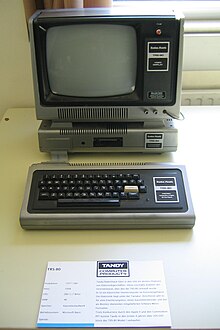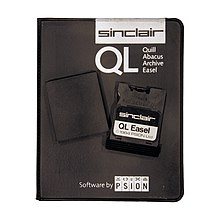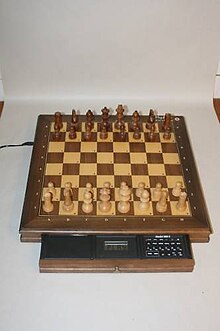Richard Lang (programmer)
Richard Lang (* 1956 in Wokingham ) is a British chess programmer and entrepreneur. In the 1980s and sometimes beyond, he was considered the best programmer of chess software. His programs reached a high level for the time , especially in the final, and were also able to achieve success against world chess and grandmasters .
Studies, profession and European championship
Richard Lang completed his physics studies with a first master's degree at Imperial College London , where he also acquired knowledge of the mathematically oriented programming language Fortran . After graduation, he worked in the utility industry for a while, working for British Gas on research experiments into the safety of natural liquefied gas development.
In January 1981 he bought a Tandy home computer TRS-80 Model 1 (Z80 CPU clocked at 1.7 MHz) from Radio Shack . After being interested in chess before, he tried a self-written chess program. He had the 1978 published book by Dan and Kathe Spracklen about their chess program Sargon swallowed that a full list of commands of the Z80 Zilog - assembler contained. He saw several opportunities for improvement, not only in terms of speed, but also in better algorithms and ways to get a score for chess positions. When compared to a commercial chess program bought for his computer, his own performed better. He then developed his program, which was written in assembler, and won the European championship with it under the name Cyrus I in autumn 1981.
Intelligent software and Psion
After this success, the computer specialist David Levy bought the program that Lang had developed as an employee of "British Gas" in his spare time, and offered the 25-year-old programmer to work in his company Intelligent Software . Lang was enthusiastic about the opportunity to turn his hobby into a profession and soon after joining Intelligent Software developed his first officially published chess program Cyrus II from Cyrus I. Under this name, it became part of an early Sinclair computer over time as well the commercial chess computer La Regence (named after the Paris chess temple Café de la Régence ), L'Empereur and later Chess 2001 . The current versions of ChessGenius still contain a lot of the former hobby program Cyrus I. For example, Lang (at least until 2003) did not use dynamic search trees, but instead relied on a static exchange routine.
In 1984 Lang went self-employed and worked with the software company Psion for software on IBM-PC, Apple , Atari ST and Sinclair QL . In the same year he took part in the World Chess Championship for Microcomputers (WMCCC) in Glasgow with his new program under the name Psion Chess . The program ran there on a SAGE II with a Motorola 68000 8 MHz processor. PSION took first place along with three other programs. This PSION program was then sold to Sinclair Research for the Sinclair QL. In early 1985, an improved version of PSION came out for the Macintosh , and soon thereafter a similar version for the IBM personal computer .
Mephisto
In May 1985, Lang came into contact with the Munich company Hegener & Glaser and found great support there. He was able to improve his program in the months leading up to the World Cup in Amsterdam at the beginning of September and won over Mephisto . The winning program from Amsterdam came onto the market as a module for the 68000 Mephisto computer clocked at 12 MHz and became known under the name "Mephisto Amsterdam". At about the same time a PSION version for the 8 MHz ATARI ST was created.
After his convincing renewed title win in 1985 in Amsterdam, Lang won all subsequent world championships safely up to 1990 with his constantly improved programs on Mephisto. The record series includes seven titles as world champion of microcomputers from 1984 to 1990 and ten titles from 1984 to 1993 for programs. In addition to the team of the management consultant and chess expert Ossi Weiner, many other strong chess players supported him in developing his programs in the search for errors and inaccuracies. With her active help, Lang created chess programs that were successful even against strong players and grandmasters and earned him the nickname "The King". His World Cup program from 1989 won the German Blitz Championship with ease on the Mephisto Portorose 68030 in 1990 and was able to defeat former world champion Karpov and the exceptional German player Robert Huebner during a simultaneous performance . In 1991 the Lyon program (successor to Portorose) held a lightning match against former world champion Michail Tal . The Vancouver program won confidently in March 1992 against the entire German chess elite in a tournament with 1 hour per game.
PC versus microcomputer
The long undisputed position of "King Richard" only began to crumble at the 1991 World Cup in Vancouver. He could "only" defend his title in the manufacturer group. The title in the software group went to the well-known Dutch programmer Ed Schröder with his ChessMachine . On the one hand, the multitude of programming competition had not been inactive in the meantime. On the technical side, the rapid development in personal computers towards super-fast hardware had led to a drop in prices that the microcomputer manufacturers could not keep up and brought them into considerable economic difficulties. On the other hand, unknown programmers were now able to use fast processors, which were clearly superior to the hardware of the Mephisto computers.
Richard Lang answered the challenge in his own way in 1993. Although his programs were written in the complicated assembly language, he managed to port them to the PC within six months. In this short time he not only had to change the program logic and optimize it for the new processor, but also to develop the graphical user interface (with external support). With this achievement, Lang once again demonstrated his talent for programming.
The new PC program called Chess Genius quickly took one of the top positions in the Swedish rating list for chess computers. At the 1993 World Cup, Lang achieved a good third place in the software group with Chess Genius 2. In the manufacturer group, Hegener & Glaser and Richard Lang won with their Mephisto wonder machine (a 486 PC / 66 MHz with Chess Genius 2, built into a Mephisto Munich board) just before the TASC R40 . Mephisto was also able to win the playoff for the absolute world champion with 1.5: 0.5 against HIARCS . In 1994 Lang defeated the then world champion Garri Kasparow with his Genius 3 in an official competition at the Intel World Chess Grand Prix in two 25 minute rapid chess games with 1.5: 0.5. At the 13th WMCCC 1995 in Paderborn, Richard Lang shared the title of “Professional Microcomputer Chess World Champion” with Marty Hirsch, although his Chess Genius only came in second after the final evaluation. In the subsequent playoff for the title of "absolute microcomputer chess world champion" Richard was defeated by the new world champion M-Chess .
In the period after that, Lang brought out a few versions of his successful Chess Genius program, but no longer came up trumps in spectacular competitions. As an entrepreneur, he dealt with the implementation of his program on PDAs , smartphones and other mobile devices.
literature
- Dan Spracklen, Kathe Spracklen: Sargon: A Computer Chess Program. Hayden Book Company, 1978, ISBN 0-8104-5155-7
Web links
- Portrait photo accessed December 9, 2017
- Meet the authors of the most famous Chess Programs. Richard Lang's ChessGenius. In: Homepage of Schröder BV and their chess software Rebel, Mephisto MM5, Mephisto Polgar, Mephisto Milano and Mephisto Risc as well as the PC-based Mephisto Gideon. Ed Schröder, accessed August 28, 2013 .
Individual evidence
- ↑ a b c d e f g Richard Lang. In: Lang, Richard. Schachcomputer.info - Wiki, accessed on August 20, 2013 (biography of Richard Lang, edited from 2005 to 2013).
- ↑ One of the "Big Six" Energy Suppliers (the six largest energy companies in Great Britain)
- ↑ a b c Richard Lang. (PDF; 17 kB) Question & Answer Interview given to a German magazine in 2003. In: Chess Computer UK. Mike Watters, 2003, accessed on August 20, 2013 (English, interview by Richard Lang to a German specialist journal from 2003).
- ↑ a b c d e Göran Grottling and Richard Lang: Mr. Lang, where is the depth? (422 kB) The Swedish chess computer tester Göran Grottling interviews Richard Lang for the Swedish club magazine PLY. In: www.schaakcomputers.nl: 12-1987, module 4/1987, pp. 34–38, Göran Grottling: Interview with Richard L. 1987, accessed on August 20, 2013 (pdf file).
- ↑ see literature
- ↑ Richard Lang. In: Lang, Richard. Chess Programming Wiki, accessed on August 20, 2013 (short presentation, programs and photo ACM 1989 in Reno, edited from 2009 to 2013).
- ↑ Ossi Weiner, a German engineer and architect, chess player, computer chess expert, co-author of computer chess books, author of chess openings as well as entrepreneur and dealer for computer chess and games was a management consultant at Hegener & Glaser , he represented Mephisto chess computer at various world championships for computers and games Microcomputer, which led to a long-term collaboration with Richard Lang and Ed Schröder . In 1983, Weiner his own company, the hobby computer center, Weiner Vertriebs GmbH in Munich , the predecessor of 1997 together with his partner Hegener Manfred founded Millennium 2000 GmbH .
| personal data | |
|---|---|
| SURNAME | Lang, Richard |
| BRIEF DESCRIPTION | British chess programmer and entrepreneur |
| DATE OF BIRTH | 1956 |
| PLACE OF BIRTH | Wokingham |



